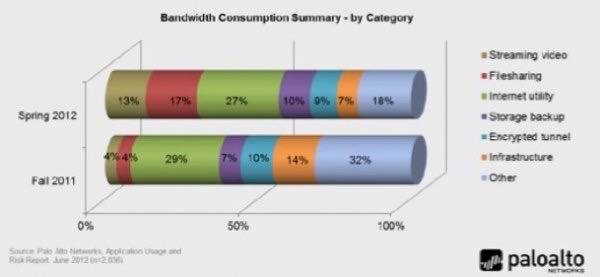Since we wrote about Palo Alto Networks’ applications study in January, the company has continued to track corporate networking trends with their customers and today is releasing a new data visualization tool, as well. Somewhat surprisingly, they are seeing very large jumps in use of peer-to-peer file sharing and video streaming services at the enterprise level.
Palo Alto conducted network traffic assessments in 2,036 organizations worldwide between November 2011 and May 2012, and found that streaming video bandwidth consumption increased more than 300%. Since its last report covering the time period from April to November 2011, “total bandwidth consumed by streaming video quadrupled to 13% of all bandwidth on enterprise networks and now represents a more significant infrastructure challenge to organizations.” And this jump doesn’t even take into account this summer’s Olympics, which may push the numbers for streaming video even higher.

The issue is pervasive, too. Palo Alto found streaming video use across 97% of its customers, using both Netflix and P2P video streaming services. In the Americas, YouTube, Netflix and generic HTTP video were the top three consumers of bandwidth. Almost half of this traffic was found on nonstandard ports (other than ports 80 and 443), making this traffic more difficult to potentially block. This is probably not due to users understanding how to hop among ports, but rather to more sophisticated streaming software that can find unblocked pathways to the Internet, as Skype and other file-sharing programs currently do. This means that monitoring and blocking tools are going to have to improve to keep track of this usage.
Palo Alto also found a similar, major jump in P2P file-sharing usage: “P2P filesharing bandwidth consumption jumped 700% to represent 14% of overall bandwidth observed, growing more than any other application category.”
At least one browser-based file-sharing application was detected on 89% of the participating organizations’ networks, and an average of 13 different file-sharing apps were found on each customer’s network. What is even more sobering is that the takedown of popular file-sharing site MegaUpload in January 2012 didn’t really put a dent in this kind of traffic. Palo Alto found that Putlocker, Rapidshare and Fileserve each benefited from the demise of Megaupload, with big jumps in usage after the takedown.
You can find the full study results here.
Their new visualization tool can be found here.

You can navigate to various screens that show you a “radar” plot of different protocols and data types from the data they have collected. This screenshot shows you the rise of P2P traffic that they have observed.
What does this mean for enterprise network admins? They will have to get better and more efficient at running their networks and squeezing as much bandwidth as they can from their existing connections. Video and peer sharing isn’t going away, and the use of both is only going to continue to grow. And those admins that don’t employ tools like Palo Alto’s and others probably need to start gaining some experience with them very soon.





















